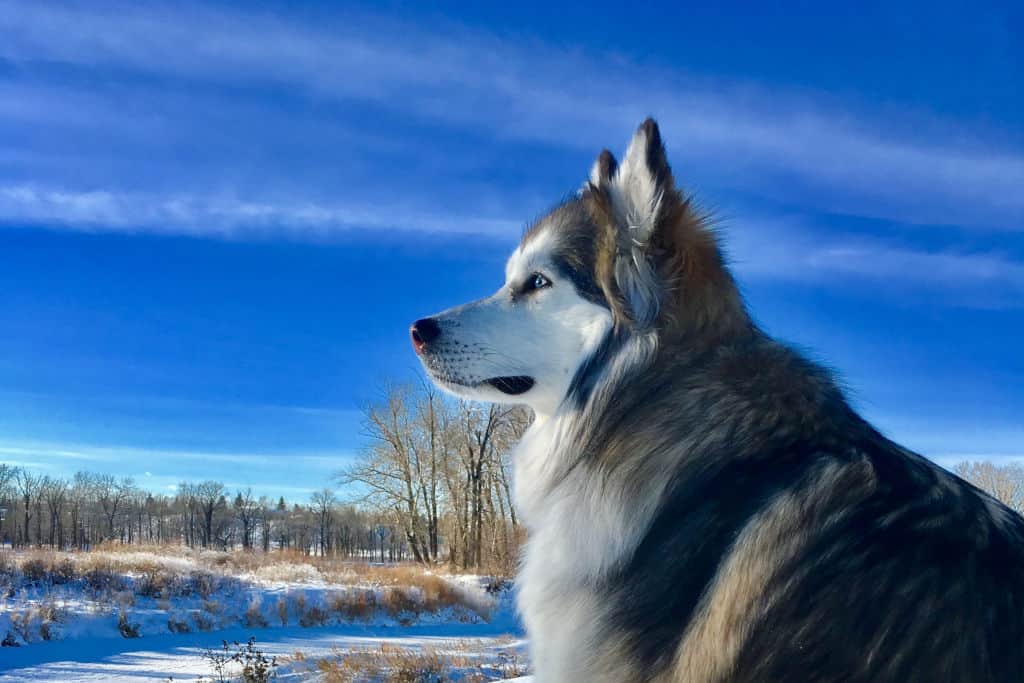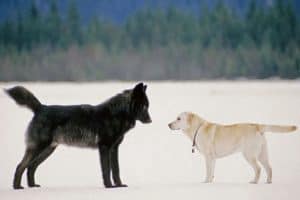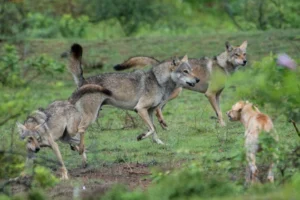Over thousands of years of domestication, dogs evolved from wolves. However, humans played a large part in their breeding as well. So, how will dogs progress?
Surprisingly, evolution does not play a role in domestic animals. According to Hardy Weinberg, dogs are not evolving because evolution conditions cannot exist without random mating. Because dogs are subjected to intense artificial selection, they will evolve in the direction determined by humans.

How Does Breeding Affect Dog Evolution?
We’ve been breeding dogs for quite some time. It is possible to argue that dogs evolved alongside humans.
On the other hand, the numerous dog breeds we see today did not evolve their distinct characteristics on their own. It happened through purposeful artificial selection by humans.
Breeding dogs with desired traits like size, temperament, coat, speed, etc., led to the wildly diverse types of dogs we see today.
Future dog breeding may involve genetic engineering or purposeful genetic modifications to fix problematic genes or produce radically different traits. For example, scientists are already creating fluorescent animals.
Interestingly, advanced genetic techniques could potentially uncover dormant genes that, when activated, yield traits long lost to ancient dog breeds. This resurgence might offer new insights into our historical relationship with these loyal companions.
But, the selective breeding of dogs for specific breed types is a relatively new phenomenon. The beginning of most dog breeds is 150-200 years old. We can ‘thank’ the Victorians for a lot of selective pet breeding and the rigid breeding of dogs to a particular standard or appearance.
With that in mind, how would dogs evolve if we stopped selectively breeding them and let them do their thing?
What Would Dogs Look Like in the Future? (if humans went away)
What would happen to dogs if we stopped artificially breeding them and went away?
If dogs are left to their own devices, they will revert to a wild type within 5-6 generations. For example, color patterns and muzzle shapes will remain points of interest.
Even if they have brindle or splotchy coats, they should fade away. Body shapes like Beagle, Terrier, and Dachshund will be more challenging to shake if they end up in the same niches as the dogs from which they were bred.
Their surroundings also affect fur types, so strange combinations may occur until they find their niches and adapt to them. Until then, you might see a long-bodied Goldie with poodle curly hair appear randomly. If they do well, some of that will stick around.
Most importantly, short-muzzled dogs would vanish quickly, so pugs and bulldogs would no longer exist like they do today, as their skulls expand to their standard shape.
If you put all dogs on one planet with no artificial barriers between them, in a few hundred years, they would all become the same breed of a feral dog, at least temporarily.
Consider Carolina Dogs or the various Street Dog breeds worldwide. After a stable population is established, these feral groups will look and act similarly.
Furthermore, once all dogs have been homogenized into a single breed, they will begin partitioning niches among natural variants across different ecosystems.
The adaptive resilience of dogs means they might form pack structures that exploit different environments, from forest terrains to urban jungles, each favoring slightly different adaptations.
It’s fun to speculate, but there’s yet to be a way to know what evolution will do. There would be variation depending on geography, but it would most likely look like a medium-built dog, not too chunky or anything, and relatively generic.

Would Dogs Revert to Wolves if We Let Them Alone?
If there is a vast increase in the number of wolves involved in the breeding, and we let them do their thing, they may eventually look like wolves. They would likely take a more wolf-like path in the wilderness than in civilized areas.
However, because most of the world is populated, they would be more likely scavengers in these areas, similar to raccoons.
Dogs are now their own species, and as long as they share an evolutionary niche with humans, they will be unable to revert to wolves.
Looking like a wolf may also not be advantageous these days, so there won’t be many environmental pressures on dogs to look like them. Coyotes and foxes are examples of Caninae. Dogs would mate with one or more medium to large canine species.
Are Dogs Evolving to Be Smarter?
One could speculate that dogs are evolving to be more intelligent due to various factors. Firstly, there’s a belief that when resources are abundant, the growth rate of a population within a niche isn’t constrained by resource availability.
Dogs’ brains, like those of all mammals, burn a significant amount of calories relative to their size. With domestic dogs having practically unlimited access to food, some theorize that this could potentially support faster brain growth, though this relationship requires more research to substantiate.
Furthermore, living in complex social structures can lead to advanced cognitive abilities. Recent studies reveal that dogs demonstrate sophisticated social intelligence and emotional sensitivity, indicating a high level of cognitive development.
However, all these theories need further scientific exploration. An increase in behaviors indicating higher intelligence, direct links between resource availability and brain size, and observable changes in dogs’ social behaviors over time are all areas that need more research.
Will Dogs Ever Evolve to Speak?
Dogs haven’t evolved a language-using part of their brain, so it’s unlikely they’ll ever be able to talk with us. They also don’t have the same vocal cords as us, so even if their brains allowed them to, they couldn’t say anything.
Even if people didn’t take care of them, dogs are pack animals that can get what they need without having to speak.
Evolution, on the other hand, does not have a set timeline. If left to their own devices, evolution would continue. It may be possible if dogs face selection pressure that favors speaking ability, but it could take a long time for them to evolve to understand and speak the language.
It’s more likely that someone will genetically engineer a talking dog.
However, doing this on purpose would be extremely difficult. You’d be opting for a potential increase in learning ability rather than just language learning. These characteristics are far more complex than coat color or size.
Multiple genes most likely control them. This makes artificial selection much more difficult to control, making it extremely difficult to breed dogs solely for their speaking ability.
Yet, advancements in neurobiology might one day allow us to decode canine thought processes, bridging the gap between our perceptions. While we may not hear dogs ‘speak’ in human tongues, technology could facilitate an understanding, providing a lens into their cognitive world.
Remember that communication in animals often transcends vocal expression. Dogs might evolve subtle, complex gestures or body language that convey detailed information, enhancing their inter-species and intra-species interactions. This form of non-verbal ‘talking’ can become pivotal in their survival and social dynamics.
Will Dogs Evolve to Smile?
Dogs have developed facial muscles due to humans and are experts at analyzing human behavior. We bred dogs that could move their muscles when they sensed our emotions. This will almost certainly continue.
Dogs cannot currently smile in the same way that humans can. On the other hand, a happy and relaxed dog will occasionally have its mouth slightly open in a smiley position. Over time, more and more dogs will be able to move their muscles in a way that makes them look like they’re smiling.
We could speculate that, eventually, there will be more dogs that can seem as if they’re smiling while not actually doing it in the way humans do it. However, it will make us feel better, and your dogs will appear to smile more.
Research suggests that the ability of dogs to ‘read’ human emotions has strengthened our bond over millennia. By understanding and responding to our emotional cues, dogs have carved an irreplaceable place in human society, a testament to evolution driven by emotional symbiosis.
FAQs
Which dog breeds are the smartest?
Breeds differ in intelligence, and their intelligence has been graded based on their trainability. Border Collies are thought to be the most intelligent dogs. Poodles and German Shepherds are in second and third place, respectively.
Will dogs ever understand English?
Dogs are unlikely to understand English because they lack a part of the brain that allows them to use and understand language. Without massive human intervention, they’d unlikely evolve to speak.
What will dogs look like in 1000 years?
It’s impossible to say what dogs will look like, especially since humans will probably intervene more and more in the genetic makeup of dogs. We can say they’d probably still bark, move their facial muscles, be more and more different from each other, and probably be more social and healthier.
Alex, a passionate animal lover, has experience in training and understanding animal behavior. As a proud pet parent to two dogs and three cats, he founded AnimalReport.net to share insights from animal experts and expand his knowledge of the animal kingdom.





You have a knack for making even the most complex subjects accessible and interesting.
I truly appreciate your technique of writing a blog. I added it to my bookmark site list and will